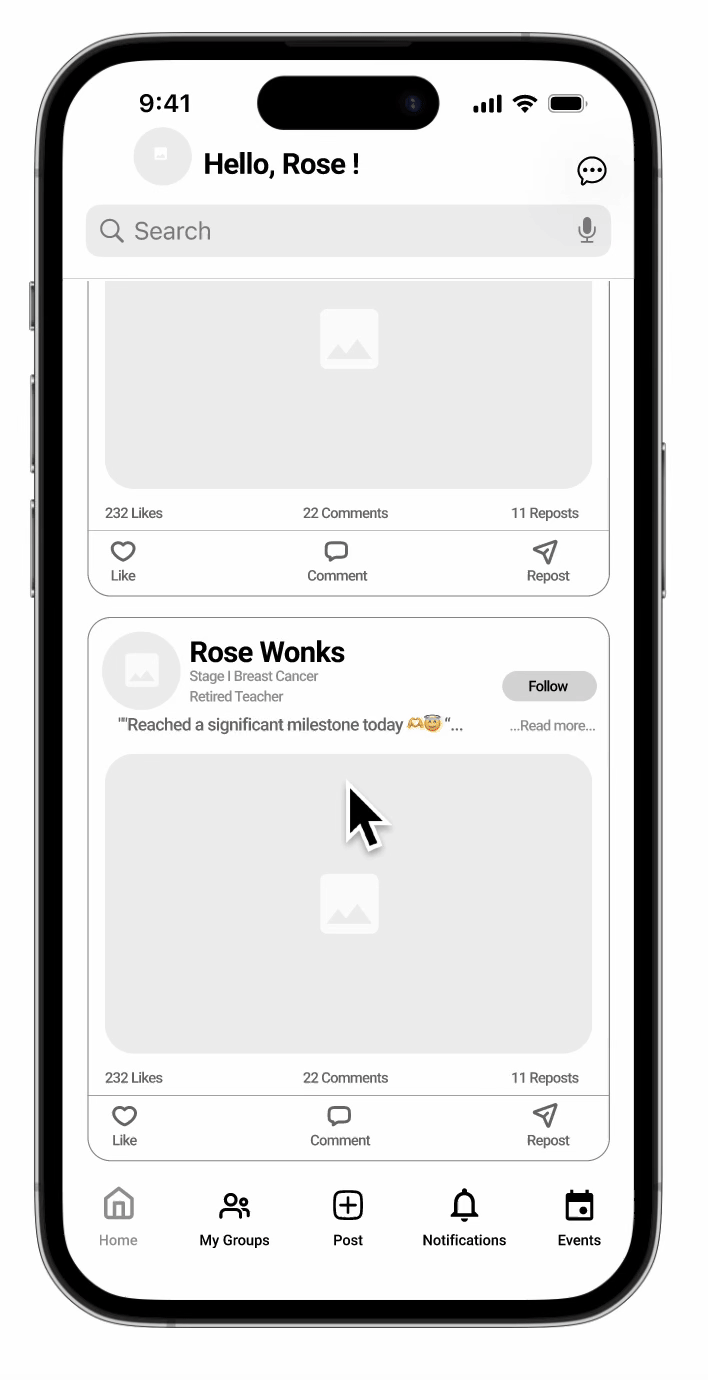
Patient First
Overview
PatientFirst, an iOS social media platform, connects breast cancer patients, fostering encouragement and sharing of experiences. It aims to combat isolation by providing a supportive community for individuals navigating similar journeys, ensuring they feel empowered and supported throughout their battle against breast cancer.
Project Type: Solo, Mid-Fi Prototype, Designed for iOS
Tools:
Figma (Wireframes, Rapid Prototyping & User Testing, Mockups)
Figjam & Adobe Photoshop
Duration: 3 Weeks
Role: UX/UI Designer
Problem Space
Problem Space
Preventing and surviving breast cancer present significant challenges for Canadian women. The rising breast cancer statistics indicate the ongoing struggle individuals face in managing this condition. It's common for patients to feel isolated during this stressful journey.
Solution
As a solution, I created an iOS application that connects individuals diagnosed with breast cancer to foster mutual encouragement and the exchange of experiences. The app's goal is to address feelings of isolation by establishing a supportive community for those going through similar experiences, ensuring they feel empowered and supported throughout their fight against breast cancer.
Research
Motivated by the pressing challenges surrounding breast cancer in Canadian women, I embarked on this research to address the rising statistics and the profound isolation experienced by patients. Witnessing the struggles individuals endure, I felt compelled to delve into understanding and offering solutions. This research aims to tackle the complexities of breast cancer prevention and survival, while also providing support and companionship to those navigating this stressful journey through both secondary and primary research methods.

Method One
Secondary Research
Then, I conducted secondary research to gain a deeper understanding of the problem space. According to my findings, it was highlighted that breast cancer has become a crucial issue among women, especially in Canada. Additionally, almost all breast cancer patients experience mental health risks while dealing with the condition, persisting even after their healing journey.
Method Two
Primary Research
After obtaining a comprehensive understanding of the current situation regarding breast cancer in women and its impact on mental health, I resolved to conduct interviews to delve deeper into understanding the challenges and identifying opportunities associated with this issue.

Hypotheses
I believe that women diagnosed with breast cancer often encounter not only physical challenges but also mental changes. I will confirm this belief if at least 2 out of 3 interviews express feelings of isolation when managing breast cancer.

Participant Criteria
To qualify for the interview, participants need to fulfill these conditions:
01. Women with breast cancer
02. Adults above 18 years old
03. Must reside in Canada
Interview Guide
Interview Guide
I compiled a series of contextual and open-ended questions. This guide not only provided structure to my user interviews but also assisted in organizing my interview notes afterward.
I found that concentrating on questions designed to understand how participants manage breast cancer, adapt to lifestyle changes and challenges, and articulate their expectations, proved advantageous in gaining deeper insights.

Participants
I interviewed three Canadian participants who have been diagnosed with breast cancer.

Affinity Mapping
After collecting notes from interviews, I arranged key points in Figjam by categorizing sticky notes into pain points, motivations, and behaviors. Next, these notes were organized into main themes through Affinity Mapping. This method unveiled meaningful patterns, with some themes emerging more prominently than others, while smaller ones were merged together.

Key Themes & Insight Statements
Once I organized the notes, I grouped them into five distinct themes. I aimed to explore the strongest themes, as they consistently represented prevalent concerns and sentiments.

Interview Insights
These were the 3 key themes that I chose to focus further.
.png)

Afterward, I decided to delve into the theme of "Emotional Support Networks Beyond Family" when crafting user stories and forming a user task flow. This theme influenced how I formulated my "how might we" statement and addressed the reality that many breast cancer patients require emotional support beyond their family's assistance due to the emotional challenges they face. Providing such support can help prevent them from feeling isolated during their journey.
HOW MIGHT WE...
How might we effectively educate and offer emotional support to assist breast cancer patients in managing their condition without feeling isolated in their journey?
"Initially, I aimed to support Canadian women in managing breast cancer without feeling isolated by providing emotional support. Prioritizing community-building and sharing experiences, my plan is to establish a supportive platform for exchanging experiences, providing emotional, educational, and resourceful aid. The ultimate goal is to ensure women with breast cancer feel informed, empowered, and connected throughout their journey."

"
By developing a user persona derived from interview findings and research, I seek to condense the varied requirements, actions, and aspirations of potential users into one identifiable character. This method yields crucial insights, nurturing empathy and comprehension, thereby informing design choices to develop a product that profoundly connects with the target demographic.

I developed a task flow inspired by the Social Posting epic to streamline user interactions. After selecting this epic, I crafted user stories that aligned with the persona's goals, pain points, and behavioral points. These stories guided the creation of a task flow, ensuring seamless navigation and functionality within the application.

Product
The outcome of this project is a mid-fidelity prototype for an iOS application that connects breast cancer patients to provide mutual encouragement and exchange experiences.
In the main task flow, users can post and share their experiences and organize events. This allows patients who are going through similar experiences to join discussions and share positivity, reassuring them that they are not alone.


